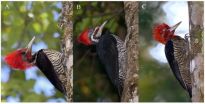(Press-News.org) HOUSTON, August 25, 2015 - Pancreatic cancer is extremely deadly and often has a poor prognosis. Ranked as the fourth deadliest cancer in the U.S. and poised to move up within the next few years, pancreatic cancer is very difficult to detect in its early stages. Seldom diagnosed early and typically spreading rapidly, the disease has no effective treatment once it advances.
University of Houston researchers are on a mission to develop drugs that will allow physicians to prolong patient survival and, possibly, even eradicate this deadliest of cancers.
"Our research on the role of liver X receptors, or LXRs, in pancreatic cancer cells points to a promising target and strategy in the treatment of pancreatic cancer," said cancer biologist Chin-Yo Lin, an assistant professor with the UH Center for Nuclear Receptors and Cell Signaling (CNRCS). "We examined the levels of LXRs in patient tumor samples and studied the effects of candidate drug compounds targeting LXRs on cultured pancreatic cancer cells."
Liver X receptors are important regulators of cholesterol, glucose metabolism and inflammatory response modulation. Collaborating with CNRCS director Dr. Jan-Åke Gustafsson, a pioneer in the discovery of LXRs and the Robert A. Welch Professor in Biology and Biochemistry in the UH College of Natural Sciences and Mathematics, Lin said there is now enough evidence to support the involvement of LXRs in a variety of malignancies.
Lin and his colleagues anticipate their ongoing studies will help determine whether LXRs are expressed in all tumors or a specific subset of tumors that might be more sensitive to drugs targeting LXRs. Another goal is to test the effects of the drugs on pancreatic tumors in murine models that are very similar to those found in humans. Ultimately, they plan to use the knowledge from these studies to develop better drugs to target LXRs in pancreatic cancer, as well as other types of malignancies.
The research team has already carried out some preliminary studies of LXR expression in patient tumor samples and is preparing to analyze more samples. Recent studies showed that chemical compounds targeting LXRs can slow the growth of tumors in murine models transplanted with human tumor cells.
"Our findings point to a class of receptors that can be precisely targeted by drug compounds and are expected to stimulate both basic and translational research on their functions and application as a drug target," Lin said. "Long-term goals are to develop additional drug compounds and clinical testing in human subjects, which will require several more years of research."
A number of students participated in these studies, including Ph.D. students Sridevi Addanki and Husna Karaboga and recent Ph.D. graduates Nicholes R. Candelaria, Trang Nguyen-Vu, Prasenjit Dey, Philip Jonsson, Jean Lin and Lakshmi Reddy Bollu. Other collaborators were professor William E. Fisher from the Baylor College of Medicine, who provided the clinical samples, and researchers Knut Steffensen and Lise-Lotte Vedin from the Karolinska Institute in Sweden, who assisted with the analysis, as well as provided some of the drug compounds.
Their research was funded by Golfers Against Cancer and a pilot study grant from the Cancer Prevention and Research Institute of Texas (CPRIT). Following the publication of some findings in the research journal PLOS ONE last year, Lin and Gustafsson recently summarized these and other advances in targeting LXRs in cancer treatments in an invited review article for Nature Reviews Cancer, a monthly journal devoted to the review of current topics in oncology.
"Our next steps are to collect more information from patient samples and data from pre-clinical studies," Lin said. "Based on the results, we will then move forward with clinical studies using existing compounds or partner with biotech or pharmaceutical companies to develop better drug candidates."
INFORMATION:
About the University of Houston
The University of Houston is a Carnegie-designated Tier One public research university recognized by The Princeton Review as one of the nation's best colleges for undergraduate education. UH serves the globally competitive Houston and Gulf Coast Region by providing world-class faculty, experiential learning and strategic industry partnerships. Located in the nation's fourth-largest city, UH serves more than 40,900 students in the most ethnically and culturally diverse region in the country. For more information about UH, visit the university's newsroom at http://www.uh.edu/news-events/.
About the College of Natural Sciences and Mathematics
The UH College of Natural Sciences and Mathematics, with 193 ranked faculty and nearly 6,000 students, offers bachelor's, master's and doctoral degrees in the natural sciences, computational sciences and mathematics. Faculty members in the departments of biology and biochemistry, chemistry, computer science, earth and atmospheric sciences, mathematics and physics conduct internationally recognized research in collaboration with industry, Texas Medical Center institutions, NASA and others worldwide.
About the UH Center for Nuclear Receptors and Cell Signaling
Established in 2009, UH's Center for Nuclear Receptors and Cell Signaling (CNRCS) is a leading component of the UH Health initiative. Led by Jan-Åke Gustafsson, a National Academy of Sciences member and world-renowned expert in the field of nuclear receptors, CNRCS researchers are involved in many aspects of nuclear receptor research, all focused on understanding the roles of these receptors in health and disease. CNRCS researchers are working toward the goal of finding new treatments for an array of significant diseases including cancer, diabetes, metabolic syndrome and neurological disorders. Working from the center's world-class labs, the researchers combine interdisciplinary research and dynamic collaboration with the Texas Medical Center and industry partners.
To receive UH science news via e-mail, sign up for UH-SciNews at http://www.uh.edu/news-events/mailing-lists/sciencelistserv/index.php.
For additional news alerts about UH, follow us on Facebook at http://www.facebook.com/UHNewsEvents and Twitter at http://twitter.com/UH_News.
Two studies in the August 25 issue of JAMA examine the effect of physical activity and nutrient supplementation on cognitive function.
In one study, Kaycee M. Sink, M.D., M.A.S., of the Wake Forest School of Medicine, Winston-Salem, N.C., and colleagues evaluated whether a 24-month physical activity program would result in better cognitive function, lower risk of mild cognitive impairment (MCI) or dementia, or both, compared with a health education program.
Epidemiological evidence suggests that physical activity is associated with lower rates of cognitive decline. ...
Among U.S. veterans who returned from Afghanistan and Iraq, being separated from the military for misconduct was associated with an increased risk of homelessness, according to a study in the August 25 issue of JAMA.
Adi V. Gundlapalli, M.D., Ph.D., M.S., of the VA Salt Lake City Health Care System, Salt Lake City, and colleagues analyzed Veterans Health Administration (VHA) data from U.S. active-duty military service members who were separated (end date of last deployment) from the military between October 2001 and December 2011, deployed in Afghanistan or Iraq, and ...
Among children with in-hospital cardiac arrest with an initial nonshockable heart rhythm who received epinephrine (adrenaline), delay in administration of epinephrine was associated with a decreased chance of 24-hour survival and survival to hospital discharge, according to a study in the August 25 issue of JAMA.
Approximately 16,000 children in the United States have a cardiac arrest each year, predominantly in a hospital setting. Epinephrine is recommended by both the American Heart Association and the European Resuscitation Council in pediatric cardiac arrest. Delay ...
In preliminary research, the detection of persistent leukemia-associated genetic mutations in at least 5 percent of bone marrow cells in day 30 remission samples among adult patients with acute myeloid leukemia was associated with an increased risk of relapse and reduced overall survival, according to a study in the August 25 issue of JAMA.
Approximately 20 percent of adult patients with acute myeloid leukemia (AML) fail to achieve remission with initial induction chemotherapy, and approximately 50 percent ultimately experience relapse after achieving complete remission. ...
For patients with an often-deadly form of leukemia, new research suggests that lingering cancer-related mutations - detected after initial treatment with chemotherapy - are associated with an increased risk of relapse and poor survival.
Using genetic profiling to study bone marrow samples from patients with acute myeloid leukemia (AML), researchers found that those whose cells still carried mutations 30 days after the initiation of chemotherapy were about three times more likely to relapse and die than patients whose bone marrow was cleared of these mutations.
The study, ...
Several Palaeozoic mass extinction events during the Ordovician and Silurian periods (ca. 485 to 420 to million years ago) shaped the evolution of life on our planet. Although some of these short-lived, periodic events were responsible for eradication of up to 85% of marine species, the exact kill-mechanism responsible for these crises remains poorly understood.
An international team led by Thijs Vandenbroucke (researcher at the French CNRS and invited professor at UGent) and Poul Emsbo (US Geological Survey) initiated a study to investigate a little known association ...
PITTSBURGH--The historic outbreak of Ebola virus disease in West Africa that began in March 2014 and has killed more than 11,000 people since, has raised new questions about the resilience of the virus and tested scientists' understanding of how to contain it. The latest discovery by a group of microbial risk-assessment and virology researchers suggests that the procedures for disposal of Ebola-contaminated liquid waste might underestimate the virus' ability to survive in wastewater.
Current epidemic response procedures from both the World Health Organization and the ...
NASA's Aqua satellite passed over Hurricane Loke as it continued moving north in the Central Pacific early on August 25.
At 01:10 UTC on August 25, 2015 (9:10 p.m. EDT/Aug. 24) the Moderate Resolution Imaging Spectroradiometer or MODIS instrument aboard NASA's Aqua satellite captured an infrared image of Hurricane Loke. The image showed the thunderstorms wrapping around the northern quadrant of the storm from east to west of the storm's center. Despite attaining hurricane status, however, there was no visible eye although microwave data taken earlier indicated an eye. ...
LAWRENCE -- To look tougher, a weakling might shave their head and don a black leather jacket, combat boots and a scowl that tells the world, "don't mess with me."
But this kind of masquerade isn't limited to people. Researchers recently have revealed a timid South American woodpecker that evolved to assume the appearance of larger, tougher birds.
Visual mimicry lets the Helmeted Woodpecker (Dryocopus galeatus) live on the threatened Atlantic forest turf of two bigger birds -- the Lineated Dryocopus lineatus and Robust (Campephilus robustus) woodpeckers -- reducing ...
August 24, 2015 - In the western foothills and mountain rangelands of the U.S., wild larkspurs (Delphinium spp.) are a major cause of cattle losses.
For the most part, grazing cattle can self-regulate consumption of larkspurs and avoid toxicity problems. However, when cattle eat too much, too quickly, or they eat low amounts continuously, toxicity can occur. Symptoms of toxicity include muscle weakness. Cattle also can become non-ambulatory and die.
In a recent study published in the Journal of Animal Science, researchers with the USDA-ARS Poisonous Plant Research ...



